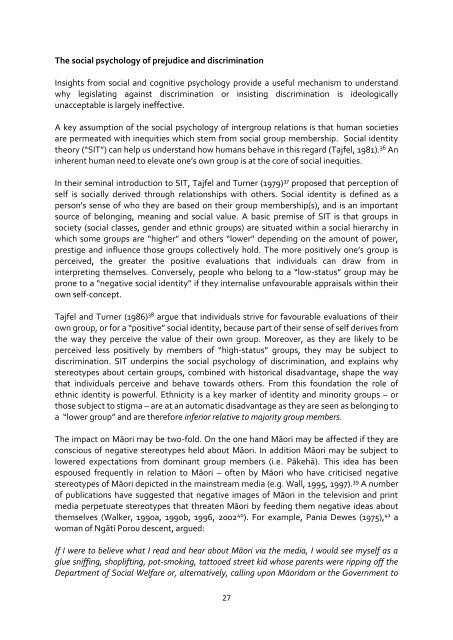UNCONSCIOUS BIAS AND EDUCATION
unconsious-bias-and-education
unconsious-bias-and-education
Create successful ePaper yourself
Turn your PDF publications into a flip-book with our unique Google optimized e-Paper software.
The social psychology of prejudice and discrimination<br />
Insights from social and cognitive psychology provide a useful mechanism to understand<br />
why legislating against discrimination or insisting discrimination is ideologically<br />
unacceptable is largely ineffective.<br />
A key assumption of the social psychology of intergroup relations is that human societies<br />
are permeated with inequities which stem from social group membership. Social identity<br />
theory (“SIT”) can help us understand how humans behave in this regard (Tajfel, 1981). 36 An<br />
inherent human need to elevate one’s own group is at the core of social inequities.<br />
In their seminal introduction to SIT, Tajfel and Turner (1979) 37 proposed that perception of<br />
self is socially derived through relationships with others. Social identity is defined as a<br />
person’s sense of who they are based on their group membership(s), and is an important<br />
source of belonging, meaning and social value. A basic premise of SIT is that groups in<br />
society (social classes, gender and ethnic groups) are situated within a social hierarchy in<br />
which some groups are “higher” and others “lower” depending on the amount of power,<br />
prestige and influence those groups collectively hold. The more positively one’s group is<br />
perceived, the greater the positive evaluations that individuals can draw from in<br />
interpreting themselves. Conversely, people who belong to a “low-status” group may be<br />
prone to a “negative social identity” if they internalise unfavourable appraisals within their<br />
own self-concept.<br />
Tajfel and Turner (1986) 38 argue that individuals strive for favourable evaluations of their<br />
own group, or for a “positive” social identity, because part of their sense of self derives from<br />
the way they perceive the value of their own group. Moreover, as they are likely to be<br />
perceived less positively by members of “high-status” groups, they may be subject to<br />
discrimination. SIT underpins the social psychology of discrimination, and explains why<br />
stereotypes about certain groups, combined with historical disadvantage, shape the way<br />
that individuals perceive and behave towards others. From this foundation the role of<br />
ethnic identity is powerful. Ethnicity is a key marker of identity and minority groups – or<br />
those subject to stigma – are at an automatic disadvantage as they are seen as belonging to<br />
a “lower group” and are therefore inferior relative to majority group members.<br />
The impact on Māori may be two-fold. On the one hand Māori may be affected if they are<br />
conscious of negative stereotypes held about Māori. In addition Māori may be subject to<br />
lowered expectations from dominant group members (i.e. Pākehā). This idea has been<br />
espoused frequently in relation to Māori – often by Māori who have criticised negative<br />
stereotypes of Māori depicted in the mainstream media (e.g. Wall, 1995, 1997). 39 A number<br />
of publications have suggested that negative images of Māori in the television and print<br />
media perpetuate stereotypes that threaten Māori by feeding them negative ideas about<br />
themselves (Walker, 1990a, 1990b, 1996, 2002 40 ). For example, Pania Dewes (1975), 41 a<br />
woman of Ngāti Porou descent, argued:<br />
If I were to believe what I read and hear about Māori via the media, I would see myself as a<br />
glue sniffing, shoplifting, pot-smoking, tattooed street kid whose parents were ripping off the<br />
Department of Social Welfare or, alternatively, calling upon Māoridom or the Government to<br />
27


